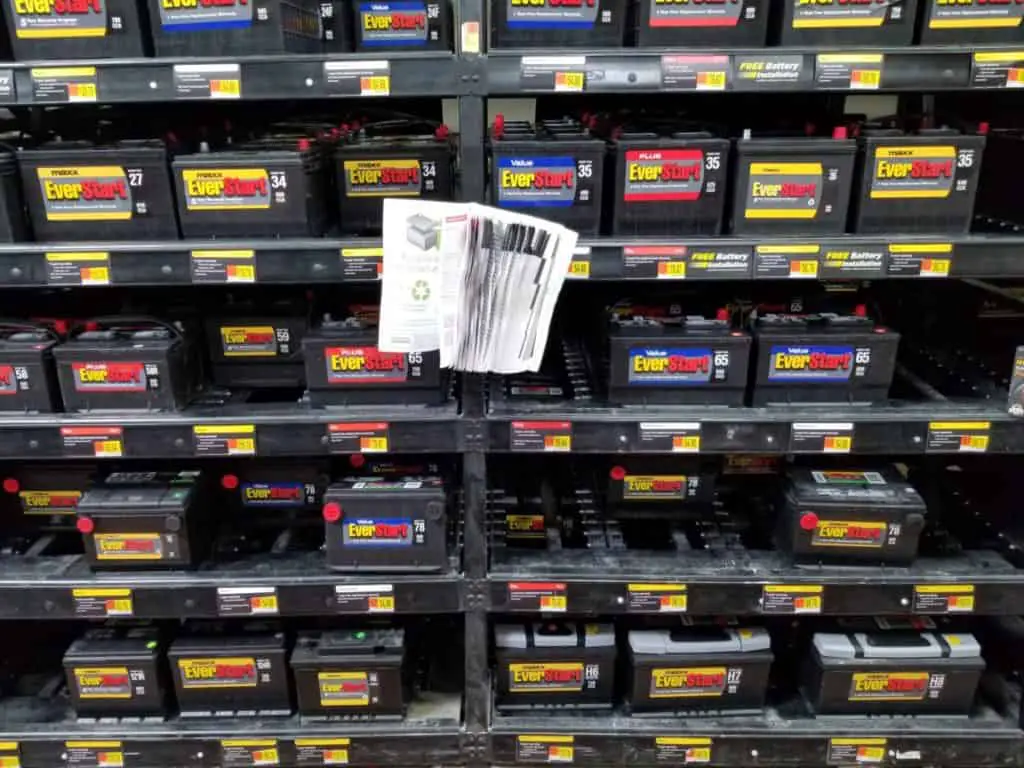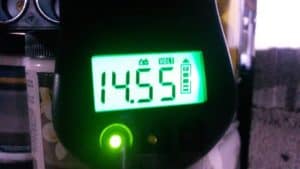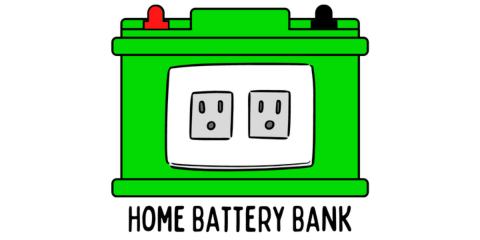You’ve decided to buy your first battery for your DIY home battery backup power (12 volts) to take care of your basic lighting and device charging needs during a power outage. You go to a local store, be it Walmart or Batteries and Bulbs, and you find quickly that the most intimidating prospect can be buying the battery itself.
You’re probably thinking, there are so many prices, and sizes! Why is this telling me CCA, this one RC and this one AMP Hours!? I see Flooded, AGM, Gel Cell!
Nevermind! Flashlights will get me through the next power outage!

I know when I first had to make the decision I was overwhelmed by the number of batteries that I found, at their various prices and the jargon and lingo on their labels.
When I was fully committed to purchasing, it took about three more weeks before I actually bought my first batteries due to my ignorance of the topic. It’s important to me that I pass on what I learned to you so that you can make a more informed decision on your first purchase.
I’m going to discuss the 8 primary factors that went into my decision making when I first purchased my batteries as well as how to make sense of the labels on the deep cycle batteries, their capacity and the application of that knowledge to determine how long you can run your lights and appliances.
12-Volt Battery Comparison of Specs
| Marine Deep Cycle 12v | GC2 Golf Cart (2 Needed) | Sealed GEL Cell 12v | Sealed AGM 12v | |
|---|---|---|---|---|
| Cost (Core charge not included) | $121 @ 105AH | $200 (for both) @ 215AH | $349 @ 97AH | $240 @ 105AH |
| Cost per Amp Hour ($) | $1.15 | $0.93 | $3.60 | $2.28 |
| Resiliency @ 50% Discharge | 300-400 Cycles | 500-600 Cycles | 750 Cycles | 1,000+ Cycles |
| Life Expectancy under Ideal Care and Use | 4-5 Years | 5-7 Years | 5-7 Years | 10+ Years |
| Safety | Can Access Acid with Screwdriver | Can Access Acid by Hand | Fully Sealed | Fully Sealed |
| Weight | 59 lbs | 60.5 lbs | 68.8 lbs | 65 lbs |
| Charging requirements | Standard Smart Charger | Standard Smart Charger | Smart Charger with GEL Setting | Smart Charger with AGM Setting |
| Availability by Type (Common Local Retailers)* | Common | Less Common | Online to Store | Online to Store |
Lead Acid Batteries
Right from the start, we are going to dismiss the car starting battery as a viable option for our home battery bank. The build and chemistry make it not suited for deep cycling and is a poor choice all around. With that being said, we are left with the other Lead Acid Batteries: Flooded (Marine or Golf Cart), Gel Cell, and AGM (Absorbed Glass Mat).
I’ll attempt a very brief and understandable explanation of each type and continue with the 8 factors that guided me through my decision-making process.
Flooded (Marine or Golf Cart)
Both of these batteries are considered “flooded” and both require regular maintenance over the course of their lives. The primary task in the maintenance process is to make sure the individual cells within the battery are flooded properly with enough water/acid. This water/acid solution will gradually evaporate out during charging and must be replaced by adding distilled water. The battery acid on both of these types can be easily accessed since they are NOT sealed. Both batteries should always be kept at full charge when not in use.
Gel Cell
This type of battery is sealed and is safer for children. Instead of a liquid solution inside it contains a gel solution impregnated between the lead plates. It requires no maintenance throughout the course of its life and only requires that you charge it properly. Charging too quickly can lead to the venting of gasses from the battery and this will reduce its life since the solution cannot be replaced. This battery also requires that you keep it fully charged when not in use. Two to three times more costly than a flooded battery.
AGM
Used by the military, this is the luxury battery to have if you can afford it. It is sealed and is safer for children. It can go longer without being charged after use and has the longest expected lifespan under ideal use and care (10+ years). Two to three times more costly than a flooded battery. Can also vent gasses if charged too quickly and the electrolyte cannot be replaced. It also offers the most discharges (be it partial or 100%) of all of the batteries above.
1. Cost
In this case, the Marine battery seems to be the clear winner for 100 Amp Hours. In fact, for many of you, it might be. It is certainly the most affordable at $100-$120 (Core charge not included) depending on where you purchase from. You could charge a phone and run a couple lights for a couple days before you would need to recharge.
I would certainly recommend this for apartment dwellers who are looking for something more portable and space saving. You could easily buy a wooden footlocker that would store the battery and charger. You could keep it open for venting purposes at all times and close it if your apartment ever undergoes fire inspection like mine did once or twice a year.
2. Cost per Amp Hours ($)
This is where the golf cart battery is the clear winner. In fact, some will probably correct me with my chart since it’s actually $0.47 per battery. However, you need two GC2 batteries (6 volts each) connected in series to get a 12-volt system.
Even though both batteries are 215 Amp Hours individually at $100 each, the entire system remains at 215 Amp Hours when they are connected in series rather than parallel. I decided to base it off of the total cost to get a functioning system.
3. Resiliency
The expensive AGM batteries are the winner in this aspect. You can get thousands of cycles when only doing partial discharges and still get 300+ uses at 100% discharge. Keep in mind though, what specific task are you trying to accomplish with your battery backup system? Are planning on being off-grid for half the year?
My only use for mine is to serve as an insurance policy that allows me to have enough power to run lights and charge devices and run a bottle warmer for my baby if the power goes out for a few days once or twice a year. I am fine spending what it would cost me to stay at a hotel for 3-4 nights if it keeps me in my own home. After one or two uses it pays for itself.
4. Life Span (under ideal use and care)
The AGM battery also excels in this category. Hopefully, with each of the others, you’ll at least get 5 years if you care for them properly. Ideally, you’ll get more time out of them since you won’t be using them constantly and hopefully you’ll be checking the water levels for maintenance if you have a flooded one. If you want to check out my article on checking water levels in a flooded lead-acid battery, you can click here.
Despite what battery you choose, just divide the total cost by the number of expected years to get a better feeling about your purchase. What it costs per year as opposed to an upfront cost always makes me feel better about a big purchase.
5. Safety
Hands down the sealed options (Gel or AGM) are the winner here. These are spill proof and the solution inside cannot be accessed by anyone including children. These can still vent off gasses if you charge too fast.
6. Weight
No matter what battery you choose, you’re going to get a workout! Keep in mind that if you go with two GC2 golf cart batteries that you can carry one in each hand and balance yourself if you’re into dead-lifting 120lbs!
7. Charging requirements
You’ll generally have no problems finding a charger for the flooded options. You’ll want to find a three-stage smart charger and maintainer for your batteries. Most will have a feature for AGM and Gel which will charge at a lower rate. I always interview my chargers first by staring at my voltmeter intently when I first use them.
The first 3 chargers I bought were from the Schumacher brand and they all took my batteries to a scary level and were boiling the batteries within minutes of plugging the charger in. NOT GOOD! I even sat and watched for about 10 minutes once thinking it was just a short cycle and would end. Wrong!
This could very well be the desulfation mode, but with the lack of information supplied by Schumacher, I don’t want them gassing excessively inside my house.
For more information on selecting a proper charger, you can check out my article here.
Sometimes the cheap date is not the best option for your new purchase. I have a Duracell charger now and a Battery Tender® charger and maintainer. I am pleased with both and trust that they won’t kill my battery bank.
8. Availability
In my local area, it is easy to find a marine battery. Golf cart batteries were harder to find and I really couldn’t get a Gel or AGM battery unless I first ordered it online and had it shipped to a store. I was pleased with the selection at Batteries and Bulbs and plan to use them for my battery needs in the future.
A Quick Breakdown of Battery-Speak
The most common standard that we rate deep cycle batteries with is AH (amp hours). It is a measure used for relative comparisons between batteries. Typically, it will tell you right on the top of the battery how many amp hours at a 20 hour rate. This is an easy way to compare the battery strengths. Unfortunately, not all batteries will make it that easy for you.
Example: 215 @ 20 hours = This battery will deliver 10.75 amps for 20 hours to give a total of 215 amp hours.
If a battery has CCA (Cold cranking amps) or Reserve Capacity (RC) as the only things listed, I generally would stay away from them since they seem to be rated more as a starting battery (like for a car or boat motor). If they were rated for amp hours I feel like it would be advertised. Still, you can get an idea what the amp hours would be by multiplying the reserve capacity by 25 (average trolling motor, unless otherwise stated on battery) and dividing by 60 minutes.
Example: (180 minutes RC x 25 amps)/60 minutes = 75 amp hours
The one thing that I wished someone had told me from the start is that the Amp Hours are determined by two factors: a specific period of time and at a specific current draw. That means that there can be more than one Amp Hour rating for the same battery if you simply change the time or the current draw! If any of these change, it renders the assumed Amp Hour rating inaccurate (rather, it shows that there can be more than one amp hour rating for battery depending on how you use it).
Do not fixate on finding an exact AH rating for a battery to fit your liking since it is like chasing a ghost! Take what rating the sticker tells you and use it for comparison reasons.
In the example above, if you take the 75 amp hour battery but the 180 minutes changes to 100 minutes and the amps to be drawn goes from 35 to 25, then it is now a 58 Amp Hour battery by changing the values (specific period of time and at a specific current draw).
The less current you draw out of the battery, the closer you will be to the advertised Amp Hour rating or exceed it. The more you draw at a specific time (especially more than the advertised amount), the less time you’ll get out of the Amp Hour rating.
Understanding Battery Capacity and Basic Application
For this example basic example I’ll use my two golf cart batteries which when hooked-up in series have an Amp Hour rating of 215.
This example is meant for practical purposes. There is A LOT more to this but we’re keeping it simple to get a general understanding.
Remember, Volts x Amps = Watts.
During a power outage, I am looking to run 4 x 4 watt LED light bulbs (16 total watts) and charge our cell phones and my daughter’s tablet (3 Devices @ 5 watts each = 15 total watts).
Total: 15 + 16 = 31 watts.
So, we take our 12-volt battery (two 6 volt GC2 batteries connected in series = 12 volts) and multiply the volts by the amp hours and we get 12v x 215ah =2,580 watt-hours.
We’ll divide the 2,580 by 2 since we don’t want to discharge our battery more than halfway if we can help it and we get 1,290 watt-hours.
1,290 watt-hours / 31 watts = 41.61 hours of continuous use.
(or: 31 watts ÷ 12 volt battery = 2.58333 amps ⇒ 215 amp hour battery ÷ 2.58333 amps = 83.22 Total hours ⇒ 83.22 Total hours @ 50% Depth of Discharge = 41.61 hours of continuous use)
This is, of course, assuming that I am running the lights at all times and charging the devices non-stop. In reality, I would probably be using the lights for 6 hours per day in the evening/night and charging our devices intermittently.
Not a bad option for a power outage. Silent, simple, and allows me to stay at home in relative comfort without having to go to a hotel. If I had to, I could even run the battery all the way down if the emergency was that bad and I would have 83 hours of continuous use at that output.
Keep the chart below in mind for gauging how much battery life you have as you go through a power outage by checking the battery voltage with a voltmeter.

Ideally, charge again from your generator or car when you get down to 70%. The next best time would be 50%. It’s an emergency though, and this system was meant to be an insurance policy — run it all the way down without feeling bad if you have to.
12-Volt Battery State of Charge
| 12.7 | 100 |
|---|---|
| 12.5 | 90 |
| 12.4 | 80 |
| 12.35 | 70 |
| 12.25 | 60 |
| 12.1 | 50 |
| 11.9 | 40 |
| 11.75 | 30 |
| 11.6 | 20 |
| 11.3 | 10 |
| 10.5 | 0 |
Final Thoughts:
In the end, I hope that this guide helps you begin your journey of selecting your first battery for your DIY home backup system. I personally chose the 2 GC2 golf cart batteries as I feel they offer the best value for the dollar spent. The chemistry and design are more durable than a marine battery by far but they aren’t as advanced as the GEL or AGM batteries –but that’s perfectly fine for my intended use from them.
Based on how often we lose power and knowing that battery backup power is for low-draw items, the batteries I chose are never going to get close to their full potential. It wasn’t worth it for me to spend more money on a GEL or AGM battery when I could put that money towards a portable generator to power my well pump and recharge my battery backup system.
I keep the batteries in a place completely inaccessible to my children, found a charger and maintainer that I could trust and it serves as a perfect insurance policy for an inevitable future power outage.
Best of luck with your selection!
